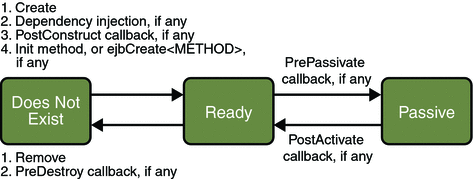The Life Cycle of a Stateful Session Bean
Figure 20–3 illustrates the stages that a session bean passes through during its lifetime. The client initiates the life cycle by obtaining a reference to a stateful session bean. The container performs any dependency injection and then invokes the method annotated with @PostConstruct, if any. The bean is now ready to have its business methods invoked by the client.
Figure 20–3 Life Cycle of a Stateful Session Bean

While in the ready stage, the EJB container may decide to deactivate, or passivate, the bean by moving it from memory to secondary storage. (Typically, the EJB container uses a least-recently-used algorithm to select a bean for passivation.) The EJB container invokes the method annotated @PrePassivate, if any, immediately before passivating it. If a client invokes a business method on the bean while it is in the passive stage, the EJB container activates the bean, calls the method annotated @PostActivate, if any, and then moves it to the ready stage.
At the end of the life cycle, the client invokes a method annotated @Remove, and the EJB container calls the method annotated @PreDestroy, if any. The bean’s instance is then ready for garbage collection.
Your code controls the invocation of only one life-cycle method: the method annotated @Remove. All other methods in Figure 20–3 are invoked by the EJB container. See Chapter 34, Resource Connections for more information.
- © 2010, Oracle Corporation and/or its affiliates
